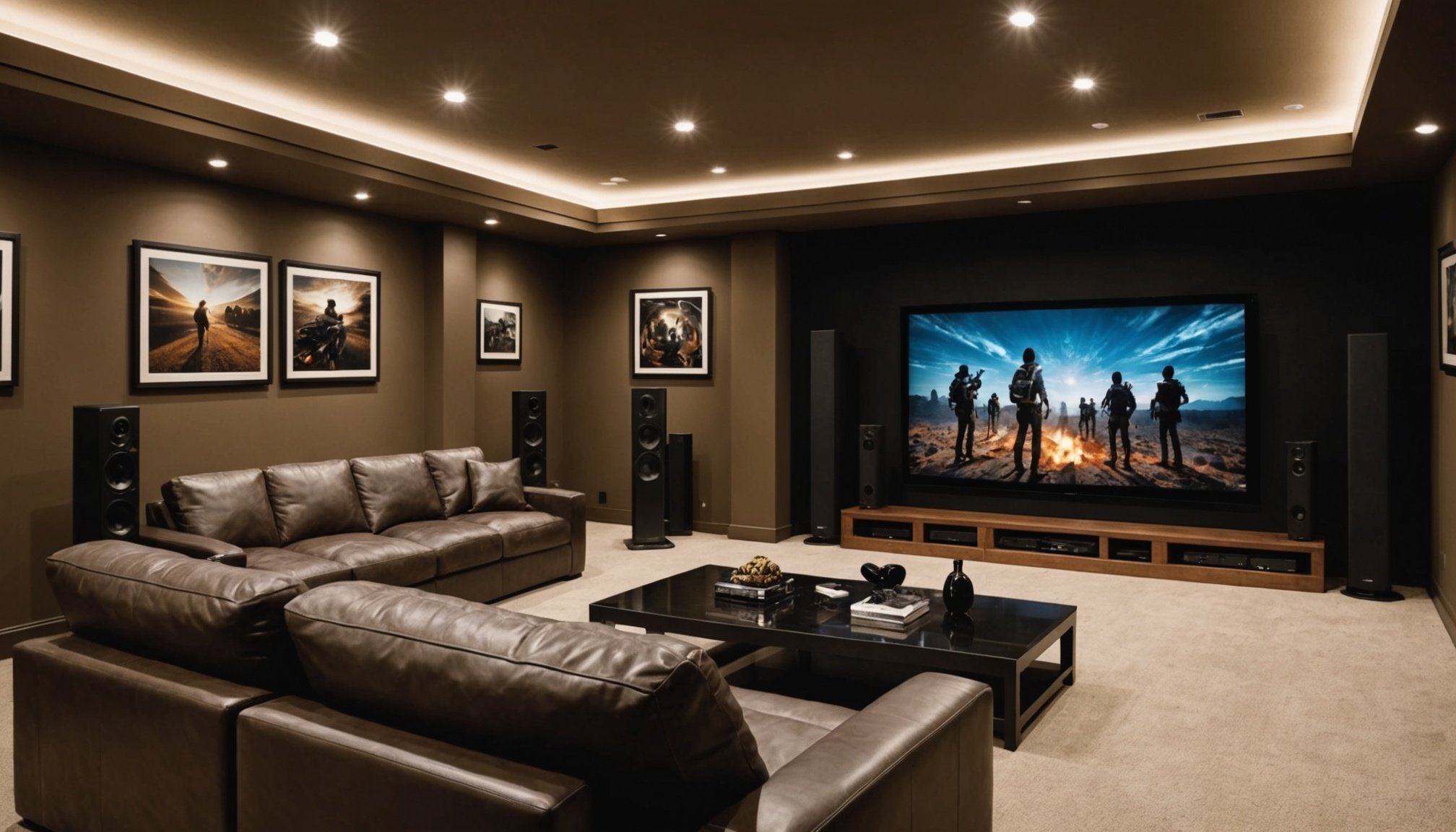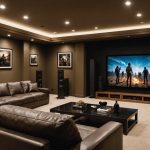Overview of Surround Sound Home Theater Systems
When aiming for the perfect home theater setup, the importance of audio quality cannot be overstated. Exceptional audio transforms your living room experience, making each movie moment immersive. There are several types of surround sound systems available, each offering unique qualities. From compact options like soundbars to elaborate setups with multiple speakers, choices cater to varied spaces and preferences.
Key features to consider include the number of channels, which enhance spatial sound distribution. Common configurations like 5.1 or 7.1 channel systems vary in speaker placement, thus impacting the richness of audio. The amplifier’s power is crucial, as it directly affects the audio quality. More power typically means sound clarity even at higher volumes.
Have you seen this : Transform your well-being: the definitive guide to crafting a digital health journal on your smartphone
Furthermore, modern systems may include wireless capabilities, simplifying installation and reducing cable clutter—a vital consideration in achieving a tidy setup. Technologies such as Dolby Atmos or DTS:X add an additional layer of depth to audio, providing a truly cinematic experience.
When investing in a surround sound system, assess the room size, your entertainment needs, and future-proof features to ensure your setup not only meets but exceeds expectations.
Also read : Enhance your mobile internet experience: mastering the best smartphone hotspot configurations!
Using Smartphones as Control Hubs
Smartphone control has revolutionised the way we interact with our audio equipment. Popular applications like Sonos and Bose Music allow users to easily manage their surround sound systems with a few taps. These apps facilitate adjusting volume, changing tracks, and selecting audio sources, all from the convenience of your handheld device.
Audio Systems and Smart Home Integration
Integrating audio systems with smart home technology extends your home automation capabilities. For instance, with platforms such as Apple HomeKit or Google Home, you can seamlessly blend your surround sound system into your existing smart home ecosystem. This setup allows for voice control through assistants like Siri or Google Assistant, offering you a more hands-free experience when managing your audio.
Benefits of Smartphone Control
The benefits of using your smartphone as a control hub are vast. Not only does it enhance ease and functionality, but it also reduces the need for multiple remote controls cluttering your living space. This solution is both practical and cost-effective, as it utilises devices you already own. Embracing smartphone control for your audio needs simplifies daily life, making home entertainment more enjoyable and straightforward.
Step-by-Step Guide to Setting Up Your System
Creating your own DIY home theater setup can be an exciting venture. With careful planning, you can achieve an impressive audio experience that rivals commercial cinemas.
Choosing the Right Equipment
Selecting suitable equipment plays a significant role in your audio installation guide. Start by assessing your room size and acoustics. Compact spaces benefit from smaller speakers or soundbars, while larger rooms might require full surround sound placement systems. Consider the balance between budget-friendly options and premium choices. High-end systems often provide superior sound quality but budget options can still offer a satisfying experience.
Recording and Mounting Speakers
Achieving optimal sound experience hinges on proper speaker placement. Arrange speakers at ear level and equidistant from your seating area. For a clean aesthetic, wall mounting is ideal, but ensure adequate wiring. Concealing wires can enhance the visual appeal and prevent clutter, using channels or in-wall installations.
Calibration and Testing
After setup, calibration is vital to refine audio performance. Utilise an audio calibration tool, adjusting speaker levels to ensure clear sound distribution. Testing your setup with movies or test tones fine-tunes the surround sound, securing an immersive experience. Regular adjustments may be needed, depending on room changes or listening preferences.
Integration with Existing Décor
Audio equipment often poses a challenge for homeowners keen on maintaining a cohesive home décor. Yet, with a few thoughtful tips, you can ensure aesthetic integration. Start by considering the room’s overall style. If you have a modern living room, sleek black or white speakers can seamlessly blend into your environment. For rustic or traditional spaces, opt for speakers with wooden finishes to ensure they complement your furniture arrangement.
Positioning is equally crucial for aesthetic purposes. Try balancing speakers symmetrically within built-in shelves or use them to create focal points, enhancing the living area without clutter. Another approach is to incorporate audio equipment into the room’s existing features, such as positioning them near plants or art pieces to create visual harmony.
One common eyesore is the tangle of wires that often accompanies high-tech setups. Use creative ways to hide wires by employing cable covers or running cords behind furniture. For a polished look, consider using decorative boxes or baskets to conceal equipment and wiring.
Overall, careful planning and consideration of your current décor can satisfactorily integrate audio equipment into any home design without compromising style or functionality.
Optimizing Audio Quality
Enhancing audio quality involves understanding the role of acoustic treatment. Acoustic treatment is essential to manage sound reflections, which can greatly affect the sound in a room. Simple solutions like placing curtains or carpets in strategic locations can absorb sound and reduce echo, providing noticeable improvement without excessive cost.
For those keen on achieving sound optimization, consider implementing these audio quality tips:
- Position speakers or monitors correctly. Positioning at ear level avoids audio distortion.
- Invest in bass traps or diffusers if budget allows, to manage low-frequency build-up.
- Use furniture and soft furnishings to naturally dampen sound reflections.
A common mistake to avoid is neglecting the room’s acoustic properties. Incorrect speaker placement, such as placing them in corners, can lead to uneven sound distribution and bass exaggeration. Similarly, relying solely on hardware without considering the room’s acoustic characteristics can hinder achieving premium audio results.
Incorporating these steps and avoiding pitfalls can significantly enhance your listening experience, ensuring clearer, more accurate sound reproduction.
Troubleshooting Common Issues
When it comes to home theater systems, facing connectivity issues and audio troubles can be frustrating. Start by ensuring all cables are securely connected and free from damage. It’s often the simplest problems that thwart audio quality. If you’re experiencing sound distortion or loss, check if the issue is specific to a particular input or device. Switching to a different input or trying another HDMI cable can sometimes resolve these technical difficulties.
Audio problems such as static or echoes can often be traced back to speaker placement. Ensure speakers are positioned correctly and that sound settings are optimized for the room’s acoustics. Removing objects that might obstruct the sound path can also improve clarity.
For persistent issues, determining when to enlist technical support is crucial. Before seeking professional help, consider DIY troubleshooting steps like restarting devices or updating firmware. However, if you’re unable to resolve the problem or notice hardware damage, it’s time to consult a professional.
Understanding these troubleshooting basics can keep your home theater system running smoothly, offering you the best audio-visual experience.
Recommended Products and Brands
In the world of surround sound, several brands stand out for their innovation and quality. Top brands like Bose, Sonos, and Samsung lead the way, each offering unique technologies and stellar performance. For instance, Bose’s sound systems are known for their spacious soundscapes, while Sonos excels in wireless connectivity, providing seamless integration. Samsung offers a variety of budget-friendly options without skimping on quality.
When selecting the best surround sound products, the category matters. For movie enthusiasts, the Bose Lifestyle 650 is a top-tier choice due to its cinematic experience. In the gaming realm, the Logitech Z906 is highly regarded for its immersive sound effects. Each product comes with its strengths tailored to different needs.
Customer reviews and expert opinions play a crucial role in decision-making. They not only highlight the strengths and weaknesses of each product but also offer real-world insights. Reviews often point out practical aspects like installation ease, sound quality, and value for money, helping consumers make informed decisions. This combination of expertise and consumer feedback is invaluable in navigating the diverse and competitive surround sound market.











